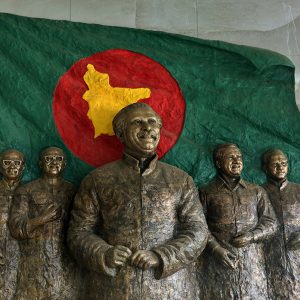
Smart Bangladesh Transformation Story
স্মার্ট বাংলাদেশের রুপান্তরের গল্প https://youtu.be/gNfLTR7ZnzE Women and girls are victims of torture Women and girls are victims of torture Women

Published by Dhaka Tribune December 08, 2020. (Link Here)
The importance of memorializing our history through sculptures cannot be understated
Sculpture is a form of art that expresses a country’s solidarity towards its history — its heroes and its glorious past, as well as political and cultural history. It reflects history and time. Over time, people used sculptures to honour great people for their work in the community, and that led to the beginning of portrait sculpting, an art that continues till date.
Sculptures represent many aspects of our history, society, and culture. Thus they are excellent for symbolism. Other than representation, sculptures also serve the purpose of beautification. Sculptures in the right place enhance overall aesthetic beauty and thus, transform a place into an art scene.
Muslim countries have aesthetic sculptures displayed in public. In the 1970s, Jeddah’s mayor initiated the “Jeddah Beautification Project.” They purchased more than 400 sculptures, which included major works by international artists such as Henry Moore, Joan Miro, and Alexander Calder, among others. These are some of the world’s most extensive and most diverse collections.
Jeddah Municipality, in collaboration with Art Jameel, not only restored the sculptures, but also increased their prominence by creating an open-air sculpture museum and also showcased 20 works in a seven square kilometre park along the middle of the Corniche in Jeddah, known locally as “Al Hamraa.”
Ottoman Sultans were pioneers of westernization movements in the culture of the Ottoman Empire in the 19th century. One example from 1871 is Sultan Abdul Aziz who had brought in CF Fuller, a sculptor from Europe, to make a sculpture of him on horseback and animal sculptures to be put in the gardens of the palace.
Today, every city and town in Turkey has at least one monument of Mustafa Kemal Atatürk (1881-1938), the founding father of the Turkish Republic, located in its most important public places. All primary, middle, and high schools have at least one sculpture of him in front of which the students have to line up every Monday morning and Friday evening to recite the national anthem.
Pakistan has hundreds of Jinnah statues all over the country. Iran, Iraq, Malaysia, and Indonesia all have hundreds of sculptures of historical figures displayed all over the country. Kuwait, Qatar, and Dubai also have sculptures of public figures.
Sculptures in Bangladesh
The construction of a sculpture of the Father of the Nation, Bangabandhu Sheikh Mujibur Rahman, has recently stirred up a lot of unwanted and unexpected controversy. Bangabandhu’s sculpture is not the first one in the country. Many significant sculptures on the theme of the Liberation War were built in the mid ’70s and early ’80s.
Sculptures of Rabindranath Tagore, Fakir Lalon Shah, Kazi Nazrul Islam, BNP founder Ziaur Rahman, Begum Rokeya Shakhawat Hossain, Pritilata Waddedar, and many other important figures were built and appreciated long before all of these anti-sculpture movements.
In my opinion, sculptures are not the main focus point of this debate. Art and religion are being politicized with an ulterior motive of pursuing hidden agendas. Worshipping idols is prohibited in Islam, but displaying sculptures is not. As long as Muslims are not kissing the feet of or putting garlands on the sculpture, it is fine to have them, to exhibit our history and culture aesthetically.
A sculpture does not undermine any religion. Thus the debate between religious statues and sculptures is an irrelevant topic. The Quran says: “Lakum dīnukum wa-liya dīnī” — this means, “For you your religion, for me my religion.”
So why shall we fight in the name of religion?
Bangabandhu Sheikh Mujibur Rahman is not only a name, he is an institution, a timeless history, and the man behind the independence of Bangladesh. He is an inspiration for the people of Bangladesh who ignited the fire of freedom in millions of hearts. He is the architect of Bangladesh.
One cannot understand the history of Bangladesh without learning about Bangabandhu Sheikh Mujibur Rahman, whose dreams flow through the veins of Bangladesh’s past, present, and future. In Bangabandhu’s Sonar Bangla, his sculpture must stand tall like a mountain.
Barrister Miti Sanjana is an Advocate of the Supreme Court of Bangladesh, partner of Legal Counsel and an activist.
Best law Firm in Bangladesh, Legal Counsel, Best Lawyers in Bangladesh, Laws of Bangladesh, history, Bangladesh, sculptures, ancient times, historical figures

স্মার্ট বাংলাদেশের রুপান্তরের গল্প https://youtu.be/gNfLTR7ZnzE Women and girls are victims of torture Women and girls are victims of torture Women

Cross-religious marriage and custody of children Published by The Daily Star | December 8, 2023 (Link Here) Cross-religious marriage and

পার্বত্য শান্তিচুক্তি, শান্তি ও সমৃদ্ধির ২৬ বছর Published by Prothom Alo | Amader Shomoy 04 November, 2023 (Link Here) Come

পাহাড়ের শান্তি | জনতন্ত্র গণতন্ত্র | https://youtu.be/QgGcvRGD_Ak Women and girls are victims of torture Women and girls are victims of

পাহাড়ের শান্তি https://youtu.be/MQmVBAbRud8 Women and girls are victims of torture Women and girls are victims of torture Women and girls
Drop Your Queries

Dhaka Office
Chattogram Office
Dhaka Office Map
Chattogram Office Map